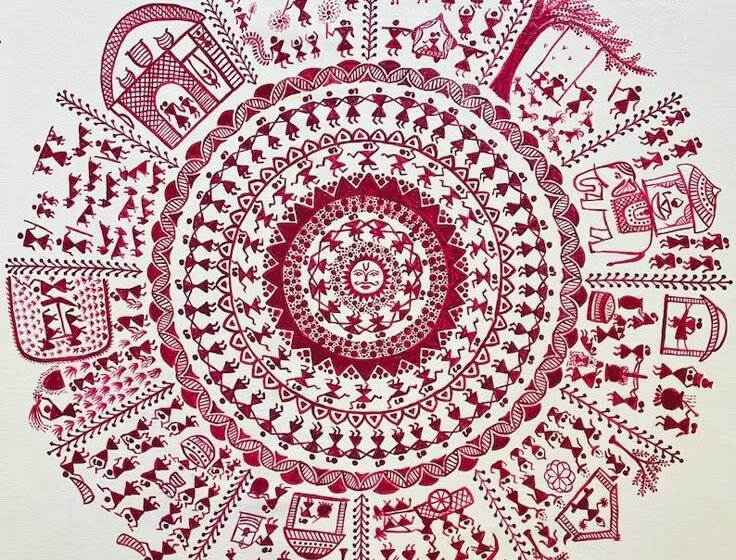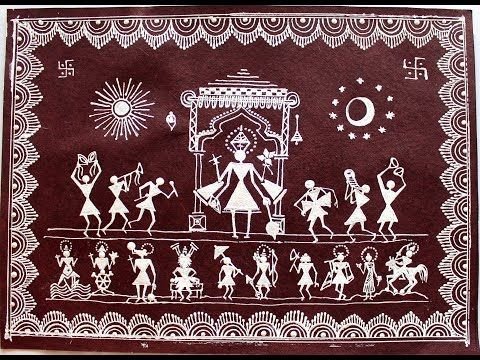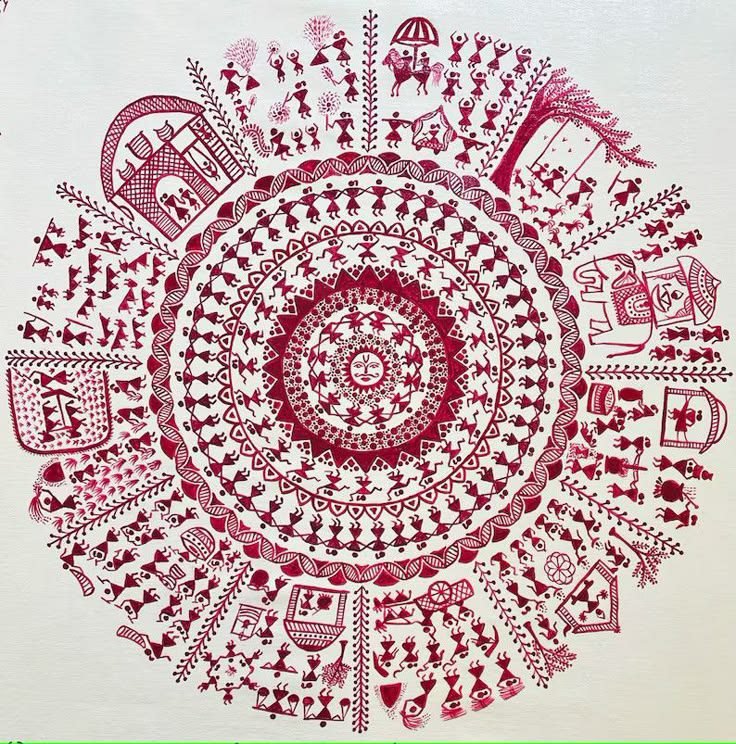Sacred Simplicity: Warli Paintings and Their Timeless Tales

India as a country has a very rich history, and we see it in its language, in its art forms and also its people. Warli painting, an art form from the Warli tribe of Maharashtra is one that is for years continued to reflect such rich culture of the country. This ancient form of art blends simplicity with profound meaning, reflecting the community’s lifestyle, beliefs, and harmony with nature. Warli paintings are characterized by monochrome designs and use simple geometric shapes to depict life and nature. Over the centuries this art has also evolved.

Origin
Warli paintings have always held a lot of importance even within the Indian folk painting/ art scene. Said to have originated somewhat around the 9th or 10th century, it has only grown as an art form that has received appreciation from all over the world. The Warli tribe, residing primarily in the outskirts of Maharashtra, practiced this art form to decorate the walls of their huts. These paintings were closely related to their spiritual beliefs, rituals, and social customs.
The term “Warli” derives from “waral,” meaning a small piece of tilled land, reflecting the tribe’s high level of appreciation of mother nature and its elements. Warli paintings were originally created during special occasions such as weddings, harvest festivals, or religious ceremonies. Painted on mud walls coated with cow dung, these artworks served both as decoration and as an expression of gratitude towards nature and their deities.

Growth
Despite its ancient history, this painting style remained lesser known until the 20th century, when artists and collectors began paying specific attention to its art. The art came to prominence in the 1970s through the efforts of cultural enthusiasts who highlighted the unique beauty and storytelling skills of Warli. Artists such as Jivya Soma Mashe played a significant role in bringing the art form to the forefront of Indian culture. Mashe’s work combined traditional themes with contemporary expressions, bringing Warli painting international acclaim. It has remained relevant today, having been adapted into many mediums, including textiles, canvas, and even products such as mugs and notebooks.

Themes
As mentioned earlier there is a very specific attention paid to using this artwork to showcase how much importance the idea of nature and mother earth holds to specifically the artists. Therefore, the themes of Warli paintings revolve around the tribe’s relationship with nature and their social structure.
Nature and Agriculture being the centre of their appreciation and often a means of economic existence was obviously paid attention to. Paintings often depict scenes of farming, planting, and harvesting, reflecting the tribe’s dependence on nature for their sustenance. Religious ceremonies and festive occasions were and continue to be commonly seen depicted in the paintings. These paintings celebrate community and the divine through depictions of dances, rituals, and offerings.
Everyday life, including hunting, fishing, and household chores, found a place in Warli art, showcasing the tribe’s connection to the land and each other. Warli art occasionally also incorporated depictions of their folklore, gods, and tribal legends, symbolizing the sacred aspect of their culture.

Artistic elements
Designs and Colours
Warli paintings are characterized by their minimalist aesthetic. Created using white pigment made from rice paste and water, these designs are painted on a reddish-brown base made from mud and cow dung. The choice of materials reflects the tribe’s resourcefulness and connection to nature.
Geometric Shapes
Warli art employs basic geometric shapes such as circles, triangles, and squares. Each shape carries symbolic significance. The circle shape often represents the sun and moon while triangle is used for mountains. Square Denotes sacred enclosures or deities often associated with rituals. A lot of people must have also noticed stick figures paintings using circles and triangles without knowing their connection with Warli art form, human forms are simplistic yet expressive. Their actions and postures convey movement, emotion, and purpose. The simplicity of this art form only makes it more endearing and invites interest from people who are not even precisely art enthusiast.

Motifs in Warli art
Muthi element
The Warli tribe gives special meaning to Muthi, sometimes known as fist. The tribe has a great tradition of drawing their fists on the walls of their huts when new rice is brought home from the fields. Almost every hut in the tribal community reflects this unique tradition. However, these characters are not only found in huts; they can be found on ploughs, granaries, inside kitchen walls and even in storage baskets.
Tapra Dance
The Tarpa dance is one of the Warli tribe’s most well-known traditional dances. The rhythmic charm of this enthralling performance is enjoyed by both men and women, and it happens at night, immediately after dinner. The Tarpa, a huge instrument expertly made by the tribe, serves as the focal point of this dance.

Wedding Ceremony Motif
In the captivating world of Warli art, numerous versions of marriage ceremony paintings are depicted. One of the common motifs showcases the wedding ceremony. This joyous scene captures the essence of celebration and togetherness among the tribal community. Marriage rituals, in particular, hold special significance in Warli art. During weddings, women paint intricate designs on walls to invoke blessings from their deities.
Scientific Aspects
While Warli paintings are rooted in spirituality and culture, they also reflect a deep understanding of ecology and social harmony. The tribe’s depiction of nature, animals, and humans in harmony underscores their sustainable lifestyle. Their art serves as a visual narrative of coexistence, emphasizing respect for the environment and interconnectedness. Additionally, the geometric precision in Warli art reveals an inherent mathematical understanding. The concentric patterns and balanced compositions showcase a keen eye for proportion and symmetry.

Legacy
Warli art has become a symbol of India’s tribal creativity. The efforts of modern artists and cultural organizations have ensured its survival. Warli art has found its way into contemporary spaces, from art galleries to fashion runways. It has been used to address social issues, promote environmental awareness, and celebrate India’s tribal heritage. The simplistic yet profound style of Warli paintings continues to inspire artists and designers worldwide.
Conclusion
Warli art is not merely a traditional art form but a vivid representation of the Warli tribe’s relationship with nature, community, and spirituality. Its simplicity, characterized by geometric patterns and earthy tones, transcends aesthetic appeal to convey stories of life and harmony. While modernization poses challenges, Warli art has found global appreciation as a symbol of sustainable and authentic living. Preserving and promoting this heritage ensures the survival of its cultural essence and empowers the artisans who carry forward this timeless tradition.


